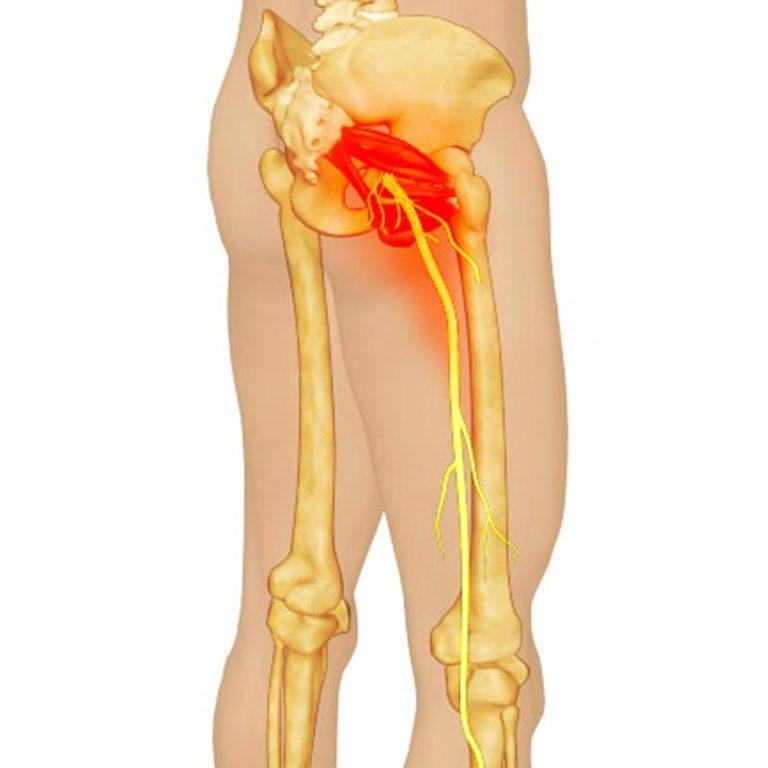What are the symptoms of piriformis syndrome?
The symptoms of piriformis syndrome typically include:
- Pain in the buttock area, which can radiate down the back of the leg (sciatica-like pain)
- Increased pain when sitting for long periods or with activities like climbing stairs
- Tenderness or aching in the buttock
- Difficulty walking or a limping gait
- Pain that worsens with hip movements, especially inward rotation
- Numbness or tingling in the buttocks or down the leg
These symptoms occur when the piriformis muscle irritates or compresses the sciatic nerve.
What are the causes of piriformis syndrome?
The causes of piriformis syndrome can vary, but they generally involve irritation, injury, or overuse of the piriformis muscle. Key causes include:
- Muscle overuse: Repetitive activities like running, walking, or cycling can lead to inflammation or tightening of the piriformis muscle.
- Trauma or injury: Direct trauma to the buttock or hip, such as from a fall or car accident, can cause muscle spasms, swelling, or scarring in the piriformis.
- Prolonged sitting: Extended periods of sitting, especially on hard surfaces, can put pressure on the piriformis and the sciatic nerve.
- Anatomical variations: In some people, the sciatic nerve may pass through or close to the piriformis muscle, increasing the risk of nerve compression.
- Muscle imbalances: Weakness or tightness in the surrounding muscles, such as the hip flexors or glutes, can place extra strain on the piriformis.
- Improper movement patterns: Poor posture, improper lifting, or incorrect form during physical activity can contribute to piriformis strain or irritation.
These factors can lead to inflammation or spasms in the piriformis, compressing the sciatic nerve and causing symptoms.
How is the diagnosis of piriformis syndrome made?
Diagnosing piriformis syndrome can be challenging, as it shares symptoms with other conditions like sciatica. The diagnosis is typically based on a combination of the following methods:
- Medical history: A doctor will ask about symptoms, such as pain in the buttock or leg, and possible triggers like physical activity, trauma, or prolonged sitting.
- Physical examination:
- Palpation of the piriformis muscle: Pressing on the buttock can reveal tenderness or pain in the piriformis area.
- Range of motion tests: Movements like internal rotation of the hip or stretching of the piriformis muscle may reproduce symptoms, confirming involvement of the muscle.
- Specialized tests: Maneuvers such as the Freiberg test, FAIR test (flexion, adduction, and internal rotation), and the Pace sign can help elicit pain or discomfort related to piriformis syndrome.
- Imaging studies: While no imaging directly confirms piriformis syndrome, they can help rule out other causes of sciatica.
- MRI or CT scans: These may exclude lumbar spine issues or disc herniations, which could cause similar symptoms.
- Ultrasound: May occasionally be used to visualize the piriformis muscle and surrounding tissues.
- Electrodiagnostic tests: Although less common, EMG (electromyography) can help assess muscle and nerve function, excluding other neurological causes like nerve compression from a herniated disc.
- Injection tests: Diagnostic injections of local anesthetics or steroids into the piriformis muscle can help determine if the muscle is causing the symptoms. If the injection relieves pain, it suggests piriformis syndrome.
The diagnosis is often made after ruling out other conditions and confirming the involvement of the piriformis muscle in causing sciatic nerve compression.
What is the treatment for piriformis syndrome?
Treatment for piriformis syndrome usually focuses on relieving pain, reducing muscle tightness, and improving mobility. It includes a combination of conservative methods and, in more severe cases, medical interventions:
Conservative treatments:
- Rest and activity modification: Reducing or avoiding activities that aggravate symptoms, such as prolonged sitting or strenuous exercise, can help the muscle heal.
- Stretching exercises: Gentle stretching of the piriformis, hamstrings, and hip muscles can relieve tension and improve flexibility. Yoga poses that target the hips and glutes are often recommended.
- Strengthening exercises: Strengthening the hip and gluteal muscles helps reduce strain on the piriformis. Core strengthening can also improve posture and balance, reducing the risk of recurrence.
- Physical therapy: A physical therapist can guide you through exercises and techniques to reduce muscle tightness, improve mobility, and correct posture or gait issues that contribute to the condition.
- Massage therapy: Deep tissue massage or trigger point therapy can reduce muscle spasms and tightness in the piriformis and surrounding muscles.
- Heat or ice therapy: Applying heat can relax tight muscles, while ice can help reduce inflammation and pain, especially after activity.
- Non-steroidal anti-inflammatory drugs (NSAIDs): Medications like ibuprofen or naproxen can reduce pain and inflammation.
Medical interventions:
- Injection therapy:
- Steroid injections: A corticosteroid injection into the piriformis muscle can reduce inflammation and provide significant pain relief.
- Botulinum toxin (Botox) injections: These can help relax the piriformis muscle, relieving pressure on the sciatic nerve.
- Dry needling: A physical therapist may use dry needling to release trigger points or muscle tightness in the piriformis.
In rare or severe cases:
- Surgery: If conservative treatments fail, surgery may be considered to relieve pressure on the sciatic nerve by releasing or lengthening the piriformis muscle. However, surgery for piriformis syndrome is uncommon.
Prevention:
- Regular stretching and strengthening exercises for the hips, glutes, and core.
- Maintaining good posture and ergonomics during activities and while sitting.
- Avoiding prolonged sitting or repetitive movements that stress the piriformis muscle.
Most people find relief with a combination of conservative treatments, and symptoms typically improve over time.

Leave a Reply
You must be logged in to post a comment.